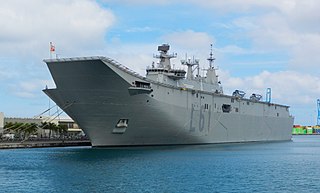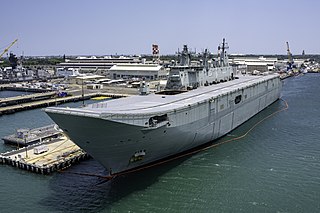
An aircraft carrier is a warship that serves as a seagoing airbase, equipped with a full-length flight deck and facilities for carrying, arming, deploying, and recovering aircraft. Typically, it is the capital ship of a fleet, as it allows a naval force to project air power worldwide without depending on local bases for staging aircraft operations. Carriers have evolved since their inception in the early twentieth century from wooden vessels used to deploy balloons to nuclear-powered warships that carry numerous fighters, strike aircraft, helicopters, and other types of aircraft. While heavier aircraft such as fixed-wing gunships and bombers have been launched from aircraft carriers, these aircraft have not landed on a carrier. By its diplomatic and tactical power, its mobility, its autonomy and the variety of its means, the aircraft carrier is often the centerpiece of modern combat fleets. Tactically or even strategically, it replaced the battleship in the role of flagship of a fleet. One of its great advantages is that, by sailing in international waters, it does not interfere with any territorial sovereignty and thus obviates the need for overflight authorizations from third-party countries, reduces the times and transit distances of aircraft and therefore significantly increase the time of availability on the combat zone.

A landing helicopter dock (LHD) is a multipurpose amphibious assault ship which is capable of operating helicopters and has a well deck. The United States Navy (USN) and the Royal Australian Navy (RAN) use the term as a hull classification symbol.

The Mistral class is a class of five amphibious assault ships built by France. Also known as helicopter carriers, and referred to as "projection and command ships", a Mistral-class ship is capable of transporting and deploying 16 NH90 or Tiger helicopters, four landing barges, up to 70 vehicles including 13 Leclerc tanks, or a 40-strong Leclerc tank battalion, and 450 soldiers. The ships are equipped with a 69-bed hospital, and are capable of serving as part of a NATO Response Force, or with United Nations or European Union peace-keeping forces.

Juan Carlos I is a multi-purpose amphibious assault ship-aircraft carrier in the Spanish Navy. Similar in role to many aircraft carriers, the amphibious landing ship has a ski jump for STOVL operations, and is equipped with the McDonnell Douglas AV-8B Harrier II attack aircraft or the new Lockheed Martin F-35B Lightning II fighter aircraft. The vessel is named in honour of Juan Carlos I, the former King of Spain.

The Canberra class is a ship class of two landing helicopter dock (LHD) ships built for the Royal Australian Navy (RAN). Planning to upgrade the navy's amphibious fleet began in 2000, based on Australian experiences leading the International Force for East Timor peacekeeping operation. With a new climate for growing Australian Navy spending, a desire existed for forward defence capability for landing and supporting troops on Asian territory, that had never existed in Australian history, even with the old Majestic-class light fleet carriers, HMAS Melbourne and HMAS Sydney in the 1970s. In 2004, French company Direction des Constructions Navales (DCN) and Spanish company Navantia were invited to tender proposals, with DCN offering the Mistral-class amphibious assault ship and Navantia proposing the "Buque de Proyección Estratégica" design. The Spanish design was selected in 2007, with Navantia responsible for construction of the ships from the keel to the flight deck, and BAE Systems Australia handling the fabrication of the combat and communications systems. Finally, Siemens (Germany) supplied and fitted the azimuth thrusters.

The Egyptian Navy, also known as the Egyptian Naval Force, is the maritime branch of the Egyptian Armed Forces. It is the largest navy in the Middle East as well as Africa, and is the twelfth largest navy in the world. The navy protects more than 2,000 kilometers of coastline of the Mediterranean Sea and the Red Sea, defense of approaches to the Suez Canal, and it also supports for army operations. The majority of the modern Egyptian Navy was created with the help of the Soviet Union in the 1960s. The navy received ships in the 1980s from China and other Western sources. In 1989, the Egyptian Navy had 18,000 personnel as well as 2,000 personnel in the Coast Guard. The navy received ships from the US in 1990. US shipbuilder Swiftships has built around 30 boats for the Egyptian Navy including mine hunters, survey vessels, and both steel and aluminium patrol boats.

A helicopter carrier is a type of aircraft carrier whose primary purpose is to operate helicopters, and has a large flight deck that occupies a substantial part of the deck, which can extend the full length of the ship like HMS Ocean of the Royal Navy (RN), or extend only partway, usually aft, as in the Soviet Navy's Moskva class or in the Chinese Navy's Type 0891A. It often also has a hangar deck for the storage of aircraft.
The Amphibious Assault Ship Project was a proposed procurement project by the Government of Canada for the Royal Canadian Navy (RCN). However, no such project was incorporated into the Government's defence plan Strong, Secure and Engaged released in 2017 and cost challenges with other naval procurement projects under the National Shipbuilding Procurement Strategy has led to no movement on the idea.

The Gowind design is a family of steel monohull frigates, corvettes and offshore patrol vessels developed since 2006 by France's Naval Group, formerly known as DCNS, to conduct missions in the littoral zone such as anti-submarine warfare (ASW). The Gowind family includes vessels with lengths from 85 to 111 metres and displacement from 1,000 tons to 3,100 tons.

An amphibious assault ship is a type of amphibious warfare ship employed to land and support ground forces on enemy territory by an amphibious assault. The design evolved from aircraft carriers converted for use as helicopter carriers. Modern ships support amphibious landing craft, with most designs including a well deck. Coming full circle, some amphibious assault ships also support V/STOL fixed-wing aircraft, now having a secondary role as aircraft carriers.

HMAS Canberra (L02) is the first ship of the Canberra-class landing helicopter dock in service with the Royal Australian Navy (RAN) and is the second largest in the Navy, succeeded by its sister ship HMAS Adelaide (L01). Construction of the ship started in Spain in 2008, with the hull launched by Navantia in 2011. The hull was then transported to Australia in late 2012 for completion by BAE Systems Australia. Canberra was commissioned on 28 November 2014.

HMAS Adelaide (L01) is the second of two Canberra-class landing helicopter dock (LHD) ships of the Royal Australian Navy (RAN) and is the largest naval vessel ever built for Australia. Construction of the ship started at Navantia's Spanish shipyard with steel-cutting in February 2010. The ship was laid down in February 2011, and launched on 4 July 2012. Delivery to Australia for fitting out at BAE Systems Australia's facilities in Victoria was scheduled for 2013, but did not occur until early 2014. Despite construction delays and predictions, the ship was commissioned in December 2015.
ENS Gamal Abdel Nasser (L1010) is an Egyptian Navy amphibious assault ship, a type of helicopter carrier, of the French-designed Mistral class. She was originally built for the Russian Navy and underwent sea trials. Subsequently, the contract was cancelled by France and agreement on compensation reached with the Russian government. Egypt and France concluded the deal to acquire the two former Russian Mistral for roughly 950 million euros.
The procurement of Landing Platform Docks (LPD) by the Indian Navy, formerly known as the "Multi-Role Support Vessel Program" (MRSV) - is an initiative of the Indian Navy to procure a series of landing platform docks, specific vessels dedicated to amphibious warfare, as part of the service's strategy to augment its capabilities of amphibious warfare, disaster-response, humanitarian assistance and auxiliary duties.

The Project 23900 Ivan Rogov is the newest class of Russian amphibious assault ships intended as a replacement for the French Mistral class, two of which were ordered by Russia in 2011, but that France refused to deliver in September 2014 due to Russia's military intervention in Ukraine. A contract was signed on 22 May 2020 for the construction of two Project 23900 ships with a displacement of 40,000 tons. The construction is led by JSC Zelenodolsk Design Bureau, which is a part of JSC Ak Bars Shipbuilding Corporation.

ENS El Fateh (971) is the lead ship of Egyptian Gowind-class corvette of the Egyptian Navy. She was commissioned on 22 September 2017.












